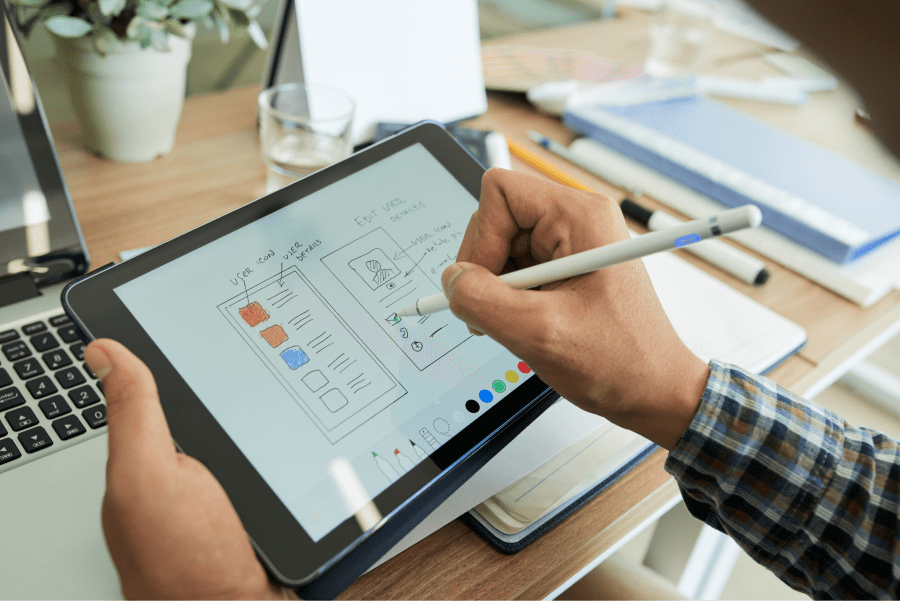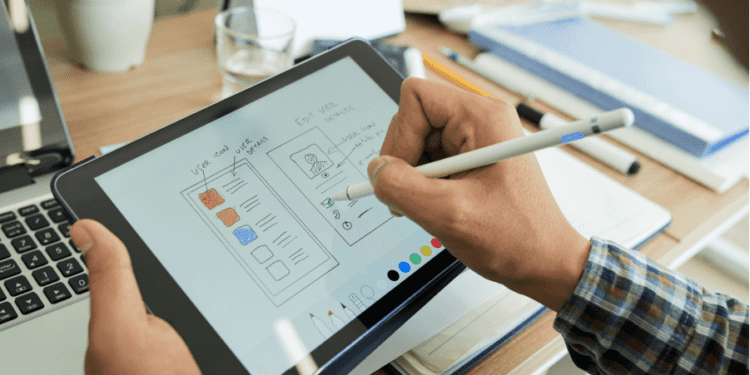App design is like all other types of design – it’s about creating something with form and function. So not only does the app have to look pretty, but it also has to work.
To achieve that, every entrepreneur needs to define and solve problems continuously.
The app design process’s essence is finding and resolving issues.

There are the main questions about app design that we need to answer:
- What do users need to do here? Do users even need to do it?
Absolutely! They need to invite their teammates to the platform to share photos.
- Does the app allow them to do that?
No.
- How can we solve that problem?
Defining and solving problems at all stages is mandatory in creating mobile apps. That’s why entrepreneurs should invest in the mobile app design process from the very beginning. Without it, all apps may end up ugly and confusing.
So, the design process is about identifying and solving problems. But what does mobile app design look like as a whole?
What is app design?
App design is an ongoing process comprising user experience (UX) and user interface (UI) elements. Designers brainstorm, define solutions, create the app’s flow and structure, and make stylistic choices from colors to fonts. The result is an app that looks nice and is easy to use.
How to become an App Designer?
To become an app designer, you generally must study computer systems at university. You usually need to gain your Senior Secondary Certificate of Education to get into these courses.
Prerequisite subjects, or assumed knowledge, are typically required in one or more of English, mathematics, chemistry, and physics. Universities have different prerequisites; some offer flexible entry requirements or external study.
What degree do you need to develop apps?
You’ll want to start with at least a bachelor’s degree; sure, a master’s may be helpful for advancement, but entry-level positions are not necessary. You’ll get farther on ingenuity and skill in computer programming than education.
Duties & Tasks of an App Designer
- Work with clients to devise app specifications
- Code apps using specialist software
- Test apps to ensure they work as intended
- Write documentation to accompany apps
- Update, repair, and modify existing apps as required.
Employment Opportunities for an App Designer
App designers work in a range of sectors and industries. They may make programs for a single company as an in-house developer or a range of programs for an agency. Application developers are highly sought-after and often work on a contractual basis.
Some app designers are self-taught and have learned via instructional books and online videos. As there are no industry standard certifications for mobile app development, this path relies on building a solid portfolio of work. Many people use the creation of an app to launch an entire business, such as Snapchat and Instagram, while other people work on a project-by-project basis.
App Design Research – Making a Business Plan
Now, the first step to designing an app is to do some research and make a plan. But first, you need a general, overarching idea. So, ask yourself the following questions:
- What problems and pain points do you want to solve?
- How might you help users with that problem?
- What kind of app are you designing?
- What is your app supposed to do?
- How is your app different from your competitors?
- What is the unique selling point of your app?
- How will your app appeal to your users?
Answering the big questions will ground your project. You’ll have a clear starting point from the beginning. Later, it will inform the app design ideas you generate for various details.
At this point, you’ll also want to consider brand positioning and strategy. You won’t want to leave your branding until the last minute, as it can also inform your mobile app design ideas.
An easy way to keep track and map out your answers to the questions above is to create a business canvas.
For those who want to research independently, start with a competitor analysis.
Ask yourself:
Are there any apps on the market that are like yours?
Research apps with attractive forms and functionality if your app is the new frontier. Refrain from reinventing the wheel if your app is a novel twist on Tinder or Uber app design. Instead, find apps on Product Hunt with similar features and functionalities and excellent app design elements.
Make a list of things you admire and want to do better. Then, take notes, make a mood board, and organize your app design ideas. The idea is to gather plenty of information before brainstorming with your designers.
Finally, you’ll want to build user personas.
- Who is going to use your app?
- What does that person need?
- What are their pain points?
- Where do they live?
- What’s their demographic?
- What do they like? Or dislike?
App Design Process Final Steps – Testing, Feedback, Iteration
App design always continues. But once you have an MVP, you can finally start testing your app and getting feedback from real users.
You’ll want to create customer or user feedback loops to get feedback. So you have a constant source of insight. And once you get feedback, you’ll want to implement it by redesigning and updating your app.
But how do you create feedback loops?
First, you should design customer feedback loops right into your product. That can be as simple as creating a survey that asks your users about their experience.
Second, you should ensure plenty of places for users to leave ratings and reviews. That can include your:
- App Store Profile
- Social Media Profiles
- Google My Business Page
- Website
Of course, this list still needs to be completed, and you may have other review sites in mind depending on what your app sells.
Third, you can consider different types of ongoing app design testing, including:
- Focus Groups
- Usability Tests
- QA Testing
- A/B Testing
Everyone you know should be testing your app by using it, including you.
App maintenance is all about running tests, gathering feedback, analyzing that feedback, and updating your app. Testing isn’t a “final stage.” It’s going back to the beginning of the app design process over and over again.
You can think of the process as “always beta” – constantly testing new iterations of your app with a limited number of users.
Helpful Tips. You may consider launching a pure “beta” version of your app. Your MVP can serve that purpose. The idea is to deliver a working version of your app to a limited number of users. They understand it’s still in development, but you test it in a live environment.
In conclusion, app design is a challenging and fast process. It’s an ongoing investment and a commitment to making sure your app works and looks good. Think of design as the alpha and omega of creating a mobile app.
That’s why it’s essential to ensure that you’ve got a solid team and process before you move on to anything else.
Great app design is about making sure that you define and solve problems constantly. Then, if you manage, you can create an app that people will love to use.
As you can see, app design is like all other types of design – it’s about creating something with form and function. And not only does the app have to look pretty, but it also has to work.


